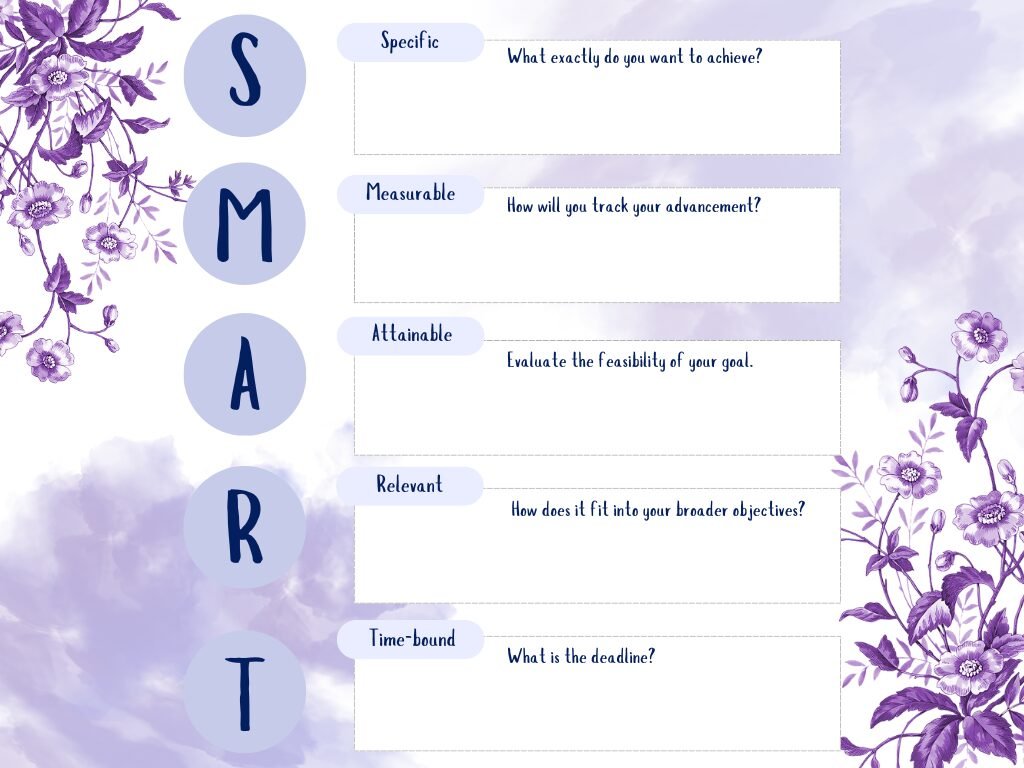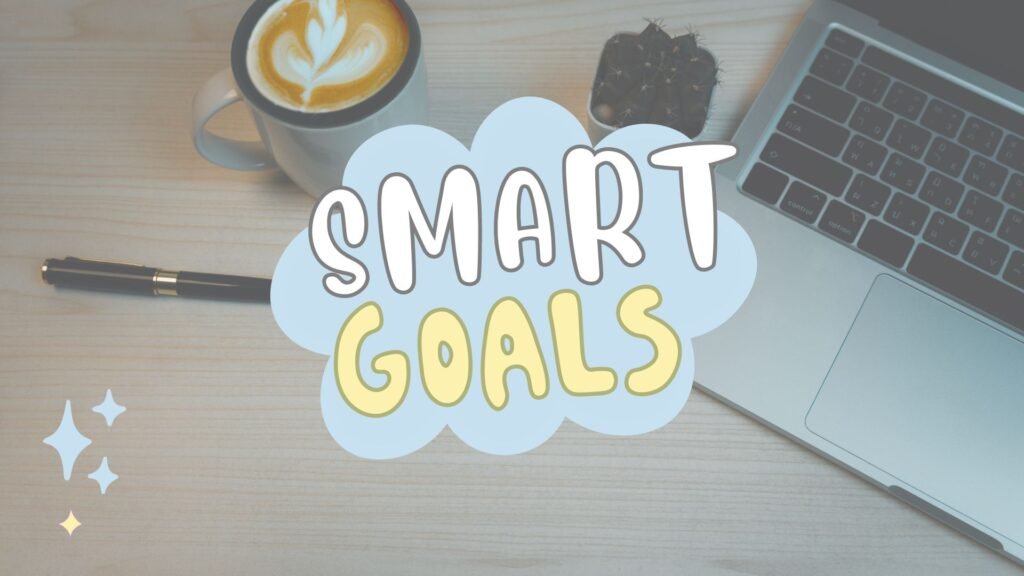Hi beautiful,
Have you set goals before and failed to reach them? Maybe it was a fitness plan abandoned by February, a career goal that fizzled out, or a savings target that never became a reality.
Don’t worry the problem isn’t you, it’s the way you traditionally set goals.
Research from the University of Scranton shows that only 8% of people achieve their New Year’s resolutions.
This is because when goals are vague, motivation fades quickly.
The Problem with Vague Goals
Saying “I want to get fit” or “I want to save money” sounds good, but it’s too broad. These kinds of goals fail because they lack details.
They don’t include:
- Specificity – What exactly do you want to achieve?
- Measurability – How will you track progress?
- Actionable Steps – What should you do next?
How to Set SMART Goals
The good news is you can achieve your goals by changing your approach.
Replace vague ideas with clear, actionable plans. Be specific about what you want and how you’ll get there.

What are SMART Goals?
SMART is an acronym that stands for:
- Specific
- Measurable
- Achievable
- Relevant
- Time-Bound
These components ensure that your goals are clear and reachable.

Specific
Your goals should be clear and specific so you know exactly what you’re working toward.
Ask yourself:
- What do I want to accomplish?
- Why is this goal important?
- Who is involved?
- Where is it located?
- Which resources or limits are involved?
For example, instead of saying, “I want to get fit,”
say, “I want to lose 10 pounds in three months by exercising five times a week and following a balanced diet.”
Measurable
A goal without a measurable outcome is like a sports competition without a scoreboard. Numbers are essential.
To measure your progress, ask:
- How much?
- How many?
- How will I know when it’s accomplished?
For instance, if your goal is to save money, specify an amount: “I will save $5,000 in a year by saving $100 each week.”
Achievable
Your goal needs to be realistic and attainable to be successful. It should stretch your abilities but remain possible.
Consider:
- How can I accomplish this goal?
- How realistic is the goal, based on other constraints?
For example, aiming to run a marathon next month might be unrealistic if you haven’t been training. Instead, set a goal to run a 5K in three months.
Relevant
This step ensures that your goal matters to you and aligns with other relevant goals. You need support and assistance in achieving your goals, but it’s important to retain control over them.
Ask:
- Does this seem worthwhile?
- Is this the right time?
- Does this match our other efforts/needs?
For instance, if your goal is to advance in your career, ensure it aligns with your long-term objectives and current job demands.
Time-Bound
Every goal needs a target date, so you have a deadline to focus on and something to work toward. This part of the SMART goal criteria prevents everyday tasks from taking priority over your longer-term goals.
Ask:
- When?
- What can I do six months from now?
- What can I do six weeks from now?
- What can I do today?
Setting SMART goals turns your dreams into structured plans, which makes it easier to stay focused and motivated.
Here’s a practical example:
Let’s say you want to write a book. Saying “I want to write a book someday” is vague.
But with a SMART goal, you can create a clear plan:
- Specific: “I want to write a 200-page science fiction novel.”
- Measurable: “I will write 10 pages per week.”
- Achievable: “I have time to write for two hours every evening.”
- Relevant: “Writing a book aligns with my passion for storytelling and my career goal of becoming an author.”
- Time-bound: “I will complete the first draft in five months.”
A Step-by-Step Guide to Set SMART goals

Ready to set your own SMART goals?
Here’s how you can do it:
Step 1: Define Your Goal
What you want to achieve? Think about it and write it down clearly.
Step 2: Make Your Goal Specific
Be specific.
Instead of saying “I want to get fit,” say “I want to run a 5K race in 30 minutes.”
Step 3: Make Sure Your Goal is Measurable
Set clear ways to measure your progress. Decide how you’ll track your advancement.
For example, track your weekly running time and distance covered.
Step 4: Check if Your Goal is Achievable
Make sure your goal is realistic given your current situation. Do you have enough resources and time to achieve it?
Step 5: Is Your Goal Relevant?
Align your goal with your long-term plans. Ask yourself if this goal is important and fits with your other goals.
Step 6: Set a Time Frame
Decide when you want to achieve your goal. Set a deadline.
For instance, “I will complete my 5K run within three months.”
Examples of SMART Goals
Here are some examples to inspire you:
Personal Development Goals
- Specific: Read one book per month on self-improvement.
- Measurable: Track the number of pages read each day.
- Achievable: Choose books with around 300 pages.
- Relevant: Enhances knowledge and personal growth.
- Time-Bound: Complete each book within a month.
Career Goals
- Specific: Earn a promotion to a managerial position.
- Measurable: Achieve specific performance targets set by your employer.
- Achievable: Gain necessary skills through training.
- Relevant: Aligns with career aspirations.
- Time-Bound: Aim to get promoted within two years.
Health and Fitness Goals
- Specific: Lose 10 pounds.
- Measurable: Track weight loss each week.
- Achievable: Follow a balanced diet and exercise plan.
- Relevant: Improves overall health and well-being.
- Time-Bound: Achieve this goal in six months.
Financial Goals
- Specific: Save $5,000.
- Measurable: Set aside a certain amount of money each month.
- Achievable: Adjust budget to increase savings.
- Relevant: Builds financial security.
- Time-Bound: Reach the target within one year.
Common Mistakes to Avoid When Setting SMART Goals
Being Too Vague
Do not set goals that are too general. Make sure your goals are specific and detailed.
Setting Unrealistic Goals
Be realistic about what you can achieve. Analyze your current capabilities and resources.
Ignoring the Time Frame
Without a deadline, it’s easy to procrastinate. Always set a clear time frame for achieving your goals.
Not Tracking Progress
Keep checking how you’re doing. Regularly track your progress to see how you’re doing and stay motivated.
Whether you want to lose weight each week or read a certain number of pages daily, tracking helps you stay accountable.
Tools and Resources for Setting SMART Goals
Here are some helpful tools and resources to set and track your SMART goals:
Goal-Setting Apps
- Use apps like Trello, Asana, and GoalsOnTrack to organize and monitor your goals. These apps help you break down tasks, set deadlines, and see your progress.
Journals and Planners
- Keep a journal or planner to record your goals and track your daily progress.
Accountability Partners
- Share your goals with a friend or colleague to stay motivated.
The Benefits of Setting SMART Goals
Setting SMART goals offers several advantages:
Clarity and Focus
SMART goals clear up confusion and show you exactly where to go. They help you concentrate on what’s important.
For example, if your goal is to save money, setting a specific amount and deadline gives you a clear target to aim for. It keeps you focused and helps you plan your steps.
Motivation and Accountability
Clear, achievable goals inspire you to take action and feel responsible for your progress. When you have a specific goal, you stay motivated.
For instance, setting a goal to exercise three times a week pushes you to follow through and track your progress. This accountability keeps you committed.
Improved Performance and Productivity
SMART goals improve how well you perform and how productive you are. By setting measurable targets, you can see your progress and stay on track.
Whether it’s completing work projects or achieving personal milestones, SMART goals help you stay focused on your goals.
Conclusion
SMART goals map out a clear path to achieve your dreams. When you make your goals Specific, Measurable, Achievable, Relevant, and Time-Bound, each step guides you toward success.
Specific: Define exactly what you want to achieve to stay focused.
Measurable: Track your progress to see how far you’ve come.
Achievable: Set goals that you can realistically accomplish with your current resources.
Relevant: Ensure your goals matter to you and fit into your plans.
Time-Bound: Give yourself deadlines to stay motivated and on track.
Set SMART goals today to see how this approach can make a significant difference in achieving your dreams.
Whether it’s improving your health, advancing your career, or achieving personal milestones, SMART goals provide a clear framework for success. Each step forward brings you closer to your goal.
FAQs
What does each component of SMART stand for?
SMART stands for Specific, Measurable, Achievable, Relevant, and Time-Bound.
How do SMART goals improve productivity?
SMART goals make you more productive by giving you clear and specific targets to aim for. They help you stay focused and organized. By setting goals you can manage your time better and prioritize your tasks.
Can SMART goals be adjusted over time?
Yes, SMART goals can and should be adjusted as needed to reflect changes in your priorities and circumstances.
What are some examples of SMART goals?
Examples include personal development goals like reading one book per month, career goals like earning a promotion, health goals like losing weight, and financial goals like saving a specific amount of money.
How often should I review my SMART goals?
It’s a good idea to review your SMART goals regularly, such as monthly or quarterly, to ensure you stay on track and make any necessary adjustments.








Pingback: The Essential Role of Goal Setting in Your Personal Life | goalsempire.com
My goals are fitness and weight.
I’m grateful for the examples you offered; they made it simpler to grasp.
fantástico este conteúdo. Gostei muito. Aproveitem e vejam este site. informações, novidades e muito mais. Não deixem de acessar para se informar mais. Obrigado a todos e até a próxima. 🙂
Some really fantastic articles on this website, regards for contribution. “An alcoholic is someone you don’t like who drinks as much as you do.” by Dylan Thomas.
I like this weblog very much, Its a really nice place to read and find information.
I appreciate your piece of work, thankyou for all the great content.
I haven’t checked in here for some time as I thought it was getting boring, but the last several posts are good quality so I guess I will add you back to my everyday bloglist. You deserve it my friend 🙂
Whats Going down i’m new to this, I stumbled upon this I’ve discovered It absolutely useful and it has aided me out loads. I am hoping to give a contribution & help other users like its aided me. Great job.
You made some decent points there. I looked on the internet for the issue and found most guys will approve with your site.
I am not sure where you are getting your info, but good topic. I needs to spend some time learning more or understanding more. Thanks for magnificent information I was looking for this info for my mission.
I think other web-site proprietors should take this website as an model, very clean and magnificent user genial style and design, as well as the content. You are an expert in this topic!
amei este site. Para saber mais detalhes acesse o site e descubra mais. Todas as informações contidas são conteúdos relevantes e exclusivas. Tudo que você precisa saber está está lá.
demais este conteúdo. Gostei bastante. Aproveitem e vejam este site. informações, novidades e muito mais. Não deixem de acessar para saber mais. Obrigado a todos e até mais. 🙂